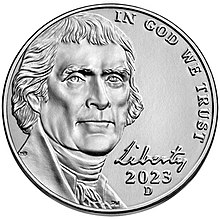United States | |
| Value | 5 cents (0.05 US dollars) |
|---|---|
| Mass | 5.000 g |
| Diameter | 21.21 mm |
| Edge | Plain |
| Composition |
"Wartime Nickels" (mid-1942 to 1945) |
| Years of minting | 1938 – present |
| Mint marks | D, S, P, W (2020 only). Located from 1938 to 1964 to the right of Monticello, except for "wartime nickels" which have a large mint mark above Monticello. No mint marks used from 1965 to 1967. From 1968 to 2004, slightly clockwise from the last digit of the date. In 2005, under "Liberty". Since 2006, under the date. Philadelphia Mint specimens before 1980 lack mint mark, except for wartime nickels, which have a P for Philadelphia if struck there. |
| Obverse | |
 | |
| Design | Thomas Jefferson |
| Designer | Jamie Franki |
| Design date | 2006–present |
| Design date | 1938–2004 (left) and 2005 (right). Struck without "FS" initials prior to 1966. |
| Reverse | |
 | |
| Design | Monticello |
| Designer | Felix Schlag |
| Design date | 1938–2003 and 2006–present. Struck without "FS" initials prior to 2006. |
| Design date | upper two designs struck in 2004; lower two in 2005 |
The Jefferson nickel has been the five-cent coin struck by the United States Mint since 1938, when it replaced the Buffalo nickel. From 1938 until 2004, the copper-nickel coin's obverse featured a profile depiction of Founding Father and third U.S. President Thomas Jefferson by artist Felix Schlag; the obverse design used in 2005 was also in profile, though by Joe Fitzgerald. Since 2006 Jefferson's portrayal, newly designed by Jamie Franki, faces forward. The coin's reverse is still the Schlag original, although in 2004 and 2005 the piece bore commemorative designs.
First struck in 1913, the Buffalo nickel had long been difficult to coin, and after it completed the 25-year term during which it could be replaced only by Congress, the Mint moved quickly to replace it with a new design. The Mint conducted a design competition, in early 1938, requiring that Jefferson be depicted on the obverse and Jefferson's house Monticello on the reverse. Schlag won the competition, but was required to submit an entirely new reverse and make other changes before the new piece went into production in October 1938.
As nickel was a strategic war material during World War II, nickels coined from 1942 to 1945 were struck in a copper-silver-manganese alloy which would not require adjustment to vending machines. They bear a large mint mark above the depiction of Monticello on the reverse. In 2004 and 2005, the nickel saw new designs as part of the Westward Journey nickel series, and since 2006 has borne Schlag's reverse and Franki's obverse.